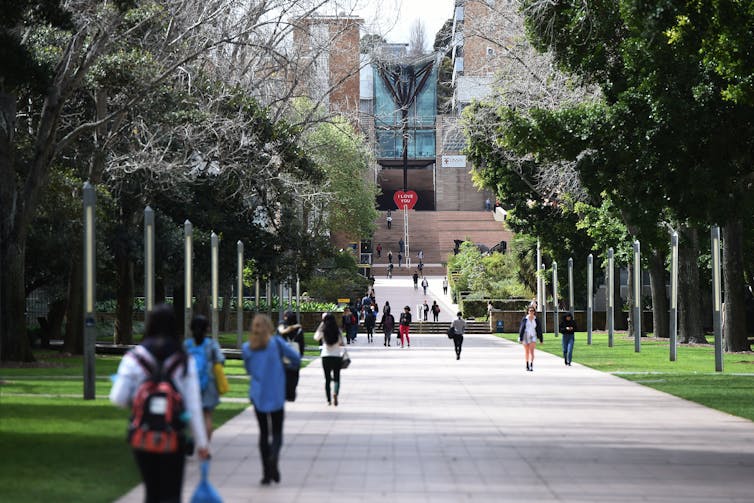Yes, some students are dropping out of teaching degrees, but not at the rate you think
- Written by Shane Dawson, Executive Dean UniSA Education Futures, University of South Australia

We know Australian schools are in the grip of a teacher shortage. Federal and state education ministers are currently putting together a plan[1] to fix it, which is due in December.
One of the key planks so far is making sure more students finish their teaching degrees.
Federal Education Minister Jason Clare has regularly cited Education Department data[2] which shows people are not finishing their teaching degrees[3] at higher rates than other fields of study. This is based on looking at student cohorts over a six-year period. As he said last month[4]:
50% of young people who go into a teaching degree finish it. On average it’s about 70% of people who go into any other degree finish it. Now what’s going wrong there?
At first glance these figures are alarming. But they are also an overly simple and misleading way to look at the issue. In fact, completion rates for teaching degrees are comparable to other similar programs.
What are university completion rates?
University completion rates are worked out using the total number of students who start a degree for a given year and then calculating the percentage of this group who graduate four, six or nine years later.
For example, assume 100 students start a teaching degree in 2012. A 50% completion rate translates to 50 students completing that degree by 2018 (six years post commencement is the generally noted range).
Comparatively, the average for other programs is noted as 70% – meaning that in the same time frame and with the same commencing number of students, 70 students completed their degree by 2018.
Read more: Too many people drop out of teaching degrees – here are 4 ways to keep them studying[5]
Three year degrees vs four year degrees
While the figures for teaching degrees look grim, it is important to note that degrees are not all of the same duration.
Three-year degrees are most common at the undergraduate level, but there are also four and five year bachelor degrees.
Undergraduate, teaching (education) programs are four years. This means a student doing part-time study will take eight years to graduate. This muddies the calculations.
For example, let’s compare a three-year bachelor of science degree with a four-year bachelor of education. Let’s assume they each have 100 students and the retention rate is 90% for each year of study. In this example, the completion rate for the three year program is 73%. For a four-year program with the same retention rate that figure drops to 65%.
The retention rate is the same in both examples, but the completion rate changes because the degree takes one year longer.
So, if we are going to look at completion rates over a six-year period (as Clare is doing with that headline figure), it would be to more accurate to compare teaching degrees with other four-year undergraduate courses.
For example, the four-year social work undergraduate degree has a six-year completion rate of 50%, like teaching degrees.
And if you look at the Education Department’s data[6] over a nine-year period (which gives people plenty of time to complete the degree part-time), the difference between teaching and other degrees is much smaller. There is a 69% completion rate for primary and secondary teacher undergraduate education compared to 73% for all other programs.
When comparing postgraduate masters-level teacher education programs, which typically take 18 months to two years full-time, the teaching qualifications have much higher completion rates. Postgraduate completion rates over a four-year time period for primary and secondary teaching are 76% compared to 71% for all other postgraduate programs[7].
What is ‘going wrong’?
While there are always improvements that can be made to teaching degrees, a more complete understanding of “what’s going wrong” is critical before planning further reforms within a discipline that has been in constant reform for most of the past decade.
Read more: Teacher shortages are a global problem – 'prioritising' Australian visas won't solve ours[8]
This is particularly the case when Clare is talking about allocating funding[9] to universities based on the “highest completion rates”.
The new national plan to tackle teacher shortages must consider how Australia can increase the number and diversity of teachers graduating and entering the workforce. At the same time, there is a dire need to address issues linked to retaining quality teachers within the profession.
The use of data to make sweeping generalisations will do little to help.
Clare’s comment
A spokesperson for Clare told The Conversation:
There is a shortage of teachers in Australia and the data shows that the graduation [rate] is still too low.
That is why the Minister has asked University of Sydney Vice Chancellor Mark Scott to lead a review into Initial Teacher Education [degrees which qualify teachers for the classroom], the details of which will be announced shortly.
References
- ^ putting together a plan (theconversation.com)
- ^ Education Department data (www.dese.gov.au)
- ^ not finishing their teaching degrees (www.skynews.com.au)
- ^ last month (www.jasonclare.com.au)
- ^ Too many people drop out of teaching degrees – here are 4 ways to keep them studying (theconversation.com)
- ^ data (www.dese.gov.au)
- ^ postgraduate programs (www.dese.gov.au)
- ^ Teacher shortages are a global problem – 'prioritising' Australian visas won't solve ours (theconversation.com)
- ^ allocating funding (www.jasonclare.com.au)














